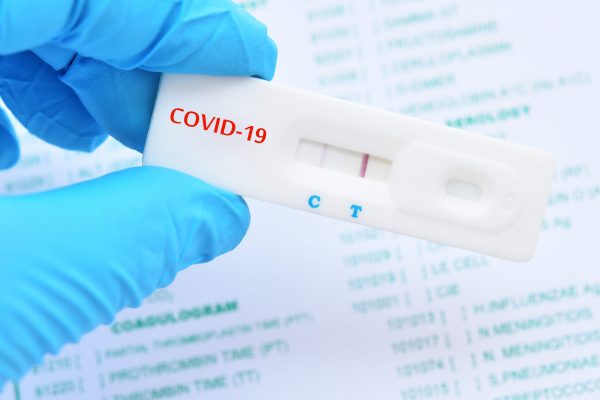As the COVID-19 continues to spread, especially into 2022, workplaces and schools have placed demands on compulsory vaccination and carrying out the COVID-19 test. Despite widespread vaccination and testing, there seem to be more Nigerians and citizens of the world at large getting infected with the coronavirus.
Read more about COVID-19
Scientists and medical experts have claimed that the variation in testing is responsible for the persisting widespread of the virus. Officially, there are two ways to run the coronavirus test. They are Rapid Antigen Testing and Polymerase Chain Reaction (PCR).
Testing can be done either in the laboratory or at home. Whatever methods one chooses to do, it is important to know what Rapid Testing and PCR are all about. In this article, we shall state the difference between Rapid Antigen Testing and Polymerase Chain Reaction and examine each methods’ pros and cons.
Rapid Test
Rapid antigen testing detects pieces of the viral proteins from the SARS-CoV-2 antigens responsible for the outbreak of COVID-19 in the body. The test does not detect the genetic material (nucleic acid from the virus). Rapid Test is quicker and it is often used to detect other viruses that cause flu, respiratory syncytial virus (RSV), and sexually transmitted infections(STIs).
The Nigerian Centre for Disease Control has approved the use of the Rapid Test method for detecting coronavirus due to its more simple, affordable, and accessible option to Nigerians, especially as an easier option for workplaces, schools, and camps. They can also produce results within an hour.
How To Get Rapid Antigen COVID Testing
There are six major steps in getting a rapid antigen test done.
Step 1: Order an RT kit online or pick it up at the pharmacy or healthcare office.
Step 2: Open the kit and read the instructions carefully. Each manufacturer differs in its instructions. The kit, in most cases, consists of a liquid, a swab, and a container or holder to put the swab in as you await the test results.
Step 3: Wet the testing area with the liquid that comes with the kit.
Step 4: Use the enclosed swab to collect your sample. This is commonly done by encircling the swab in each of your nostrils.
Step 5: Place the swab into the test kit and the swab will begin to read when it reacts with the testing surface and liquid.
Step 6: Observe carefully. You might get to see results almost immediately in form of a coloured line or another sign. It is advised that you wait for the prescribed period before drawing your conclusion. Many manufacturers suggest that one should wait for 15–30 minutes.
Sign up to the Connect Nigeria daily newsletter
Pros And Cons Of Rapid Antigen Test
Pros and Cons of Rapid Antigen Tests
Pros
- Can be performed completely at home.
- Result in less than an hour.
- Cheaper than a PCR test.
- Adequate for replication or continuous testing.
- Useful in noting the difference between cold/flu symptoms from COVID-19.
Cons
- Less efficient compared to PCR.
- Will not work if the user has no symptoms.
- The quality of the sample collected determines its accuracy.
- User mistakes can influence results.
PCR
PCR test is superior to Rapid Testing when detecting coronavirus. It has almost 100% success approval compared to rapid testing. PCR testing is performed in the laboratory or healthcare centre. The technician typically collects samples from either your nostrils, mouth or throat. The collected samples are treated with an enzyme solution and assessed under extreme amplification (duplicated multiple times). The PCR methods enable test centres to identify the precise genetic material in the sample, especially identifying the specific virus. This method can also identity variants or strains of the virus.
Due to the rigorous process of PCR, which is usually done under microscopic bits, the results are described as accurate and highly reliable – close to 100%.
On the flip side, PCR is time-consuming due to the rigorous analysis samples must undergo. Although PCR can be done quickly in emergency cases, nevertheless, it takes a few hours for the test results to come out. Furthermore, due to its reliance, there is often the case that there are numerous people who want to be examined and tested. This can often lead to delays.
Pros
- Highly accurate.
- Can detect the virus in asymptomatic people.
- Can be performed at home.
Cons
- Can be too sensitive (e.g., showing a positive result long after you are contagious)
- More expensive.
- It is time-consuming.
- Home tests must be sent to a lab for results.
Which Is Better? RAT Or PCR
There is no yes or no to this question. Both are considered useful in varying situations and symptoms. For instance, if you’re sick and you’re wondering if you’re infected with the virus, a rapid test can give you quick answers. With the results, you can know whether to isolate yourself and reduce the spread of the virus.
On the other hand, PCR is suitable for people who are persistently sick despite numerous negative tests, and those who have been exposed to people confirmed with COVID-19 are the best candidates. Although it might be expensive and time-consuming, its results are accurate.
Sources:
- Centers for Disease Control and Prevention. United States COVID-19 cases, deaths, and laboratory testing (NAATs) by state, territory, and jurisdiction. Updated November 23, 2021.
- Centers for Disease Control and Prevention. CDC diagnostic tests for COVID-19. Updated August 7, 2021.
- Crozier A, Rajan S, Buchan I, et al. Put to the test: use of rapid testing technologies for COVID-19. BMJ. February 2021;372:n208 doi:10.1136/bmj.n208.
- Hafer N. What’s the difference between a PCR and antigen COVID-19 test?. Updated November 9, 2021.
Featured Image Source: Childrensurgent
Got a suggestion? Contact us: [email protected]


